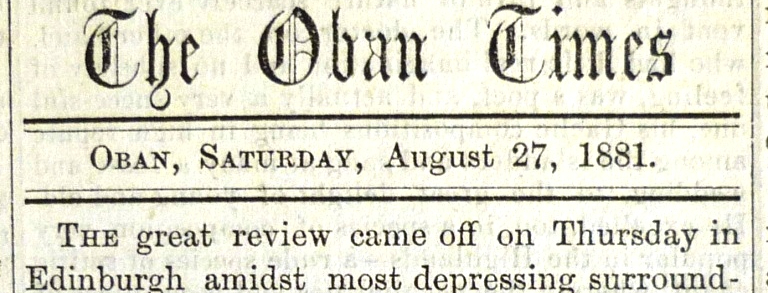It would always be remembered as the Wet Review. Queen Victoria inspected the Scottish Volunteers for a second time on 25 August 1881. Both companies of Easdale Volunteers were there, standing on parade in Holyrood Park, close to Edinburgh’s royal palace.
The weather of that year is stained indelibly on the history of Easdale. Months later, in November, an exceptionally high tide would coincide with a severe south-westerly storm and create a tidal wave, swamping Easdale Island, flooding slate quarries and destroying the livelihood of so many families. That dreadful storm had its antecedents in a deluge of rain which struck Edinburgh in late August.
The build-up to the Royal Review had started well. Captain Angus Whyte had been promoted to honorary major in recognition of his long service. He was in command of the Easdale Volunteers and in August he took them to Edinburgh. The railway had reached Oban the year before, so it is likely that the Volunteers travelled by train.
Proud men stood in Holyrood Park on Thursday 25 August. Above them a throng of spectators, estimated at three hundred thousand, sat upon the slopes of Arthur’s Seat and gazed at the spectacle below. Nearly forty thousand Volunteers awaited the Queen, almost twice the number that had paraded in 1860. Somewhere in their midst were the two companies from Easdale, commanded by Major Angus Whyte and Lieutenant Allan McNaughton.
The day had started dry but after lunch the temperature plummeted and the clouds burst open. When the Queen arrived at 4 o’clock the parade ground, already saturated from recent storms, was awash. The downpour never eased and when forty thousand Volunteers marched past the saluting dais they created a quagmire. Those towards the front, which included the Easdale men, fared better than those at the rear, for it soon became impossible to march smartly in mud that was ankle-deep. The Oban Times painted a miserable picture of the day.
The Queen, who was in an open carriage and shared some of their discomfort, was impressed by their discipline and bearing under such harsh conditions. So too were the generals. But for the men who had to wear their sodden uniforms for many more hours while they awaited tedious journeys home, the Wet Review would be remembered for less uplifting reasons.

Above – a postcard depicting the appalling weather of the 1881 Royal Review (image courtesy of McGonagall Online)
Top Photo – The Oban Times reported the Royal Review in great detail.
